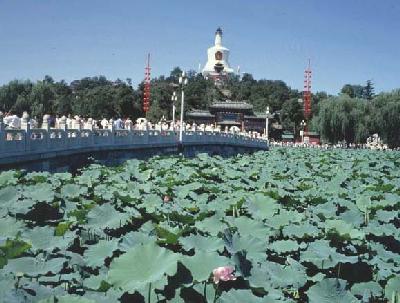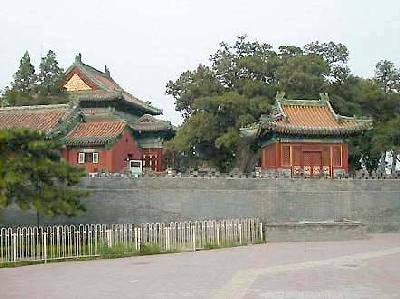| Travel in China > Protected Sites > Class Άρ > Constructions |
|
|
Beihai Park and Round City
The Beihai (North Sea) Park and the Round City are situated in Beijing's downtown, to the northwest of the Forbidden City.
The Beihai Park is about 500 meters to the northwest of the Forbidden City and the Jingshan Hill. The park is vast in its water surface, which accounts for half of the park's total area of 700,000 square meters. In the Ming Dynasty, Beihai (North Sea), Zhonghai (Central Sea) and Nanhai (South Sea) were collectively named as Three Seas or the Taiye Lake, which was the forbidden garden. At the beginning of the Republic of China, Zhonghai and Nanhai were merged into an integral whole called Zhongnanhai (Central and South Sea). Behai was separately built as a park.
The Qiong (Jade) Islet lies on the south of the lake and is the center of the whole park. It was called Qionghua Islet in the Jin Dynasty, and renamed the Wanshou Hill in the Yuan Dynasty (1271-1368). Because of the construction of the White Dagoba on the top of the hill, the Qiong Islet is also called White Dagoba Hill. The architectures on that islet were constructed in accordance with the shape of the hill, matching with each other horizontally and vertically. With the White Dagoba as the landmark, the layout of the islet can be divided into east, south, west and north parts. On the top of the Qiong Islet, the 35.9-meter-high White Dagoba was first built in the 8th year (1651) during the reign of Emperor Shunzhi.
On the south of the White Dagoba Hill stands a main building, Yong'an (Eternal Peace) Temple. Besides the temple, there are the Falun Hall, the Zhengjue Hall, the Pu'an Hall, the Bell and Drum Towers, etc. All those buildings are covered with yellow, green, purple and other colorful glazed tiles. Seen from the top of the hill, those buildings are colorful and spectacular. To the west of the Yong'an Temple is the Yuexin (Heart-joyful) Hall where emperors used to receive their officials and deal with government affairs. Behind that hall is the Qingxiao (Night Parties) Building, which was the entertainment place for emperors and queens in winters. The Linguang (Sunshine) Hall and the Yuegu (Reading the Classics) Building sit on the west of the White Dagoba Hill. The Yuegu Building was the emperors' private place for book collections. The building takes the shape of a crescent. There are 25 front pillars on the two floors. A collection of famous calligraphic works up to the Wei Dynasty (220 -265) and the Jin Dynasty (265-420) were on stone tablets rubbings, which constitute the Model Calligraphy in the Hall of the Three Rare Treasures, and amount to 495 pieces. The Three Rare Treasures referred to the three outstanding calligraphy masterpieces by Wang Xizhi, Wang Xianzhi, and Wang Xun, three pioneers in Chinese calligraphy.
On the hill slope, there are the Mujian Chamber, the Yanyun Jintai Pavilion, the Ganlu Hall, the Panqing Chamber, the Sheshan Pavilion and other ancient buildings, antique and tranquil. On the bank of the Taiye Lake there are two important building compounds that stand opposite to each other. One compound lies on the north of the White Dagoba Hill, including the Yilan Hall, the Daoning Room, the Bizhao Building, the Yuanfan Pavilion, the Yan Building, etc. The other lies on the north of the Taiye Lake, including the Wulong Pavilion and the Xitian Fanjing Pavilion. On the east of the hill there are flourishing woods, rocks, deep caves, stone bridge, memorial archway, the Zhizhu (Intellectual Pearl) Hall and the Jianchu (vision of spring) Pavilion, forming the Qiong Dao Chun Yin (Jade Islet's Spring Shadow), one of the eight beautiful sceneries in ancient Beijing. The tablet, with Qing Emperor Qianlong's inscription on it, is well preserved till today.
On the east of the Taiye Lake, pavilions and halls are hidden in green woods and waves. The Huafang Room is exquisite and graceful, and the Long Corridor winds its way deeply. That place can rival the wonderful gardens in Southeast China. To the north of the Huafang Room is the Haopu Mountain Stream, which faces the lake on its three sides. The stream is surrounded by artificial hills and zigzagging stone bridges, presenting a special view.
The Jingxin Study is the main building on the northern shore of the lake, covering an area of one hectare, which was the place where the princes studied. Emperor Qianlong used to play musical instruments and read books there, so the Jingxin Study is also called Qianlong's Miniature Garden. The garden chiefly consists of rockeries and a pond, with chambers and pavilions sitting inside, displaying various scenic views. Besides waterfalls, there are the Nine-Dragon Screen, Five-Dragon Pavilions, the Chanfu Temple, etc, all of which add charms to the study.
Originally, the Round City was an islet in the Taiye Lake. From the 3rd year to the 19th year (1163-1179) of the Dading reign in the Jin Dynasty (1115-1234), Emperor Shizong started to build palaces on the islet. The Round City, with the Qionghua Islet facing each other at a distance, is a part of the imperial palace. More buildings were constructed in the Ming and Qing dynasties (1368-1911), such as the Chengguang Hall, the Yuweng Pavilion, the Gulai Chamber, the Jingji Chamber, the Yuqing Chamber, and the Jinglan Pavilion, etc. Besides, the walls and crenels were built around the islet, forming the embryonic shape of the Round City.
The Round City, surrounded by 5-meter-high walls, has an area of 4,500 square meters. The Chengguan Hall stands in the middle of the city and is the main building inside. Covered with yellow glazed tiles, the square-shaped Chengguang Hall looks colorful and magnificent. The wooden dragon-carved shrine in the hall houses a sitting statue of Sakyamuni, carved from a block of lustrous jade, a present from Burma to Empress Dowager Cixi, contributed by a monk named Ming Kuan in the 22nd year (1896) during the reign of Emperor Guangxu in the Qing Dynasty. Empress Cixi even wrote an inscription to show her loyalty to Buddhism.
In 1900, the allied forces of eight powers invaded and occupied Beijing. They plundered the Round City and took away various treasures and antiques. Up to now, the knife-cut mark can still be seen on the left arm of the Jade Buddha. A huge jade urn is placed in front of the hall, weighing 3,500 kg. It was carved out of a whole block of jade, and was called Ocean of Jade in the Dushan Mountain. The jade block is said to be either from the Place in the Moon, or left behind by Goddess Nuwa when she sealed the sky. In the Yuan Dynasty (1271-1368), Kublar Khan, Emperor Shizu, once used the urn as a wine vessel to host officials who rendered outstanding service. While in the Ming Dynasty it was lost in society and used as a food container. In the Qing Dynasty, Emperor Qianlong found the urn in a visit and bought it at a high price. It was then placed in the Round City, and preserved in a pavilion. The emperor composed the Jade Urn Song and the Jade Urn Poem, and had them engraved on the jade urn. |
||||||
All rights reserved. Reproduction of text for non-commercial purposes is permitted provided that both the source and author are acknowledged and a notifying email is sent to us. |
||||||
 |

